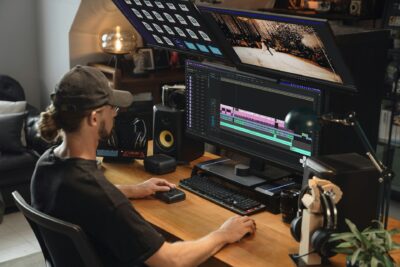Remember when Facebook and Instagram went down last October? It took nearly six hours before it got resolved. It hit hardest on startups and content creators who depended on these platforms. So now, we’re pouring all of our energy into YouTube—the most reliable, scandal-free social media platform on the market today.
With Youtube, you can use webinars to grow your audience, your influence and your sales. Here’s our 10-step formula on how to close more sales and bring more attention to your business.
Don’t Multicast Your Webinars
Many of us are used to multicasting and giving our message to everybody all at the same time. There’s nothing wrong with it until you’re presenting a webinar.
Your webinar is a place where you only want your most dedicated people, who want to connect with you and to go that distance with you.
Feel free to go live and multicast on YouTube, Twitter and all the places when promoting the webinar. But when it comes down to actually going live for your webinar, you need to avoid multicasting.
For starters, you can use Facebook groups in running your webinars. Why? All of us know how to use Facebook groups and they’re still the most popular online grouping site today. You can have a private page, a ClickFunnels site, then embed the YouTube Live. This way, you’ve got this group that’s full of people who have either registered for or have seen your webinar.
Create a Timeline

Now, what’s next? Do you make PowerPoint? Build the landing pages? Before these, the next thing you do is pick the date. You look at your calendar and think about when you’ll do the webinar.
After that, you schedule alerts that create a countdown until the day of your webinar. So if the webinar is in 30 days, then you want to have an alert that goes off 10, 7, or 3 days before the big day.
Here’s a handy tip. You can also create a link where people can sign up and get the same reminder schedules you’re getting. This helps you and your audience prepare for the webinar.
Remember, a webinar should be a recurring event that happens in your business. You should schedule at least two to three webinars at a time.
Build Your Deck
You may already have a slide deck with your main presentation, but you want to make some additions to it. This formula should help you build an effective slide deck that captures your audience’s attention and closes more sales. It includes:
- An opening slide – You want your audience to have this great opening slide to look at. A great example includes a powerful image with the title of your webinar on it or the value that they’re going to get. You can also put a picture of you with the title of your webinar, or even your QR code for your Instagram.
- Story slides – People don’t buy or spend money on anyone they don’t know. So include at least 3 or 4 story slides that show who you are and what you do.
- A clear slide that pivots to your presentation – After you introduced the title of your webinar, showed your background through your story slides, you need an effective transition. This is what the slide is for. It should tell the topic of your webinar, and what the viewers should expect from it.
- Teaching slides – These slides cover most of your webinar. So if you’re doing a webinar on how to grow your business using YouTube, you break it down into several slides consisting of a proven formula, a few tips, and the biggest takeaways they can get from it.
- Offer slides – These can be found at the last part of your webinar. The offer slides show what you sell. It should include a call-to-action (CTA), a custom URL for your order page, benefits/features in bullet points, and the price. You can add extra slides for every benefit or feature that the viewers can get once they bought your program or offer.
Set Up the Studio
When you host a webinar, you want the quality to be as great as possible. So find your own space, choose a background, set up your lights, check your sounds, screens and the rest. With the right tools and equipment, your webinars can look and sound as professional as a full studio.
Promote the Webinar
You need to have realistic attendance goals. Targeting 5-10 people on a webinar is a great start. It’s more achievable than aiming for 30-100 people, especially if you’ve only done a few webinars.
Now when it comes to promotion, you can do it in several ways. You can post on Facebook, IG stories, send a newsletter to your email list.
Most importantly, don’t hesitate to invite people personally. When somebody expresses interest or asks you a question about the webinar, take time to send a reply, and use it as an opportunity to gain another viewer. You’ll get the best results from one-to-one conversations with people.
Set Up a 5-Minute Email Before the Webinar

You probably have many things on your plate, and it’s easy to miss your webinar especially when you’re not notified. It’s the same thing that goes to your viewers. So if your webinar starts at 3 PM, you need to create an email using an autoresponder program that notifies the viewers about the webinar. Don’t forget to include the link where they can access it!
Open Up Strong
Here’s one common mistake that entrepreneurs make when doing a webinar. They talk about something that their audience doesn’t care about.
Second, they start late and keep the audience waiting. So instead of wasting time, you need a powerful opener. Greet your audience. Ask about what they’re doing, then relate it to the topic of the webinar.
And of course, start on time. The best way is to start 10 minutes early to do these things. This timeframe should help your audience get to know about you, become comfortable in the environment, so they can learn and engage with you later on.
Engage with Your Audience

You’re not only doing a webinar just to teach a few things or two about growing a business or closing more sales.
You have real people that are watching you. So use the chat, ask questions, and treat it like a live stream where you engage with your viewers. Many people miss this part because they usually pre-record their webinars.
Now how about if you see negative comments while doing your webinar? Just ignore and skip them. It might be easier said than done, but they’re not worth your time and effort. They’re not leads, and you can’t convert them to customers.
Excuse Non-Interested Parties
There are two groups of people on your webinar. There are people who want to learn more, and there are also people who got what they wanted, heard enough after watching a few slides and will probably log off before you know it.
Now you want to focus your attention on the first group of people. You want to shift your attention to those who will likely stay because they’re your leads. They want to hear your offer and you have a bigger chance of turning them to your customers.
Don’t pitch to non-buyers. If they’re not interested in buying from you, let them go.
Close Out Strong
The truth is, it can be awkward presenting to a group of people, going through your slides knowing that you’re trying to sell a $5/month Patreon subscription. But whatever the cost of your program, you need to treat it with tons of value.
Spend more time on your closing slides. Don’t be in a hurry to explain what people are getting.
When presenting using your closing slides, look at your audience. Know your offer by heart, and make sure that you clearly explain what value they’ll get from it. Some people might log off and show that they’re not interested in your offer, but the right people will.
BONUS: Track Your Results
Aside from all we’ve mentioned, here’s a bonus tip that’ll help you make more sales using webinars.
How would you know if your webinar is a success? You need to get the right numbers and track them. Of course, it’s not all about the money. Before you get into sales, track:
- The number of people registered – This refers to the number of people who had an interest in attending your webinar, so they registered for it.
- Show up ratio and cost – This refers to the percentage of people that showed up versus registered, and how much it cost each of them
- Purchase ratio and cost – This refers to the number of people that saw your pitch versus the people who purchased, and how much it cost each of them.
Need Help in Making More Sales?
If you want to learn more about webinars, and how to run a successful, profitable one that scales your businesses, email us at [email protected].




